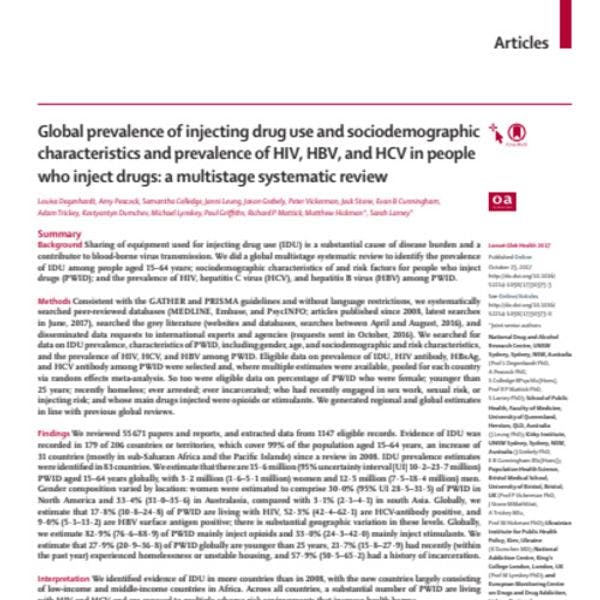Prévalence mondiale de l’injection de drogues et caractéristiques sociodémographiques de la prévalence du VIH, du VHB et du VHC parmi les usagers de drogues injectables : un examen systématique à plusieurs niveaux
La recherche estime qu’il y a 15,6 millions d’usagers de drogues injectables âgés de 15 à 64 ans dans le monde, dont un nombre important qui vivent avec le VIH et le VHC et sont exposés à des environnements défavorables à risques, qui augmentent les dommages à la santé. Pour en savoir plus, en Anglais, veuillez lire les informations ci-dessous.
Abonnez-vous à l'Alerte mensuelle de l'IDPC pour recevoir des informations relatives à la politique des drogues.
By Prof Louisa Degenhardt, PhD; Amy Peacock, PhD; Samantha Colledge, BPsychSc[Hons]; Janni Leung, PhD; Jason Grebely, PhD; Prof Peter Vickerman, PhD; Jack Stone, MMathStat, Evan B Cunningham, BSc[Hons]; Adam Trickey, MSc; Kostyantyn Dumchev, MD; Prof Michael Lynskey, PhD; Paul Griffiths, MSc; Prof Richard P Mattick, PhD; Prof Matthew Hickman, PhD; Sarah Larney, PhD.
Background
Sharing of equipment used for injecting drug use (IDU) is a substantial cause of disease burden and a contributor to blood-borne virus transmission. We did a global multistage systematic review to identify the prevalence of IDU among people aged 15–64 years; sociodemographic characteristics of and risk factors for people who inject drugs (PWID); and the prevalence of HIV, hepatitis C virus (HCV), and hepatitis B virus (HBV) among PWID.
Methods
Consistent with the GATHER and PRISMA guidelines and without language restrictions, we systematically searched peer-reviewed databases (MEDLINE, Embase, and PsycINFO; articles published since 2008, latest searches in June, 2017), searched the grey literature (websites and databases, searches between April and August, 2016), and disseminated data requests to international experts and agencies (requests sent in October, 2016). We searched for data on IDU prevalence, characteristics of PWID, including gender, age, and sociodemographic and risk characteristics, and the prevalence of HIV, HCV, and HBV among PWID. Eligible data on prevalence of IDU, HIV antibody, HBsAg, and HCV antibody among PWID were selected and, where multiple estimates were available, pooled for each country via random effects meta-analysis. So too were eligible data on percentage of PWID who were female; younger than 25 years; recently homeless; ever arrested; ever incarcerated; who had recently engaged in sex work, sexual risk, or injecting risk; and whose main drugs injected were opioids or stimulants. We generated regional and global estimates in line with previous global reviews.
